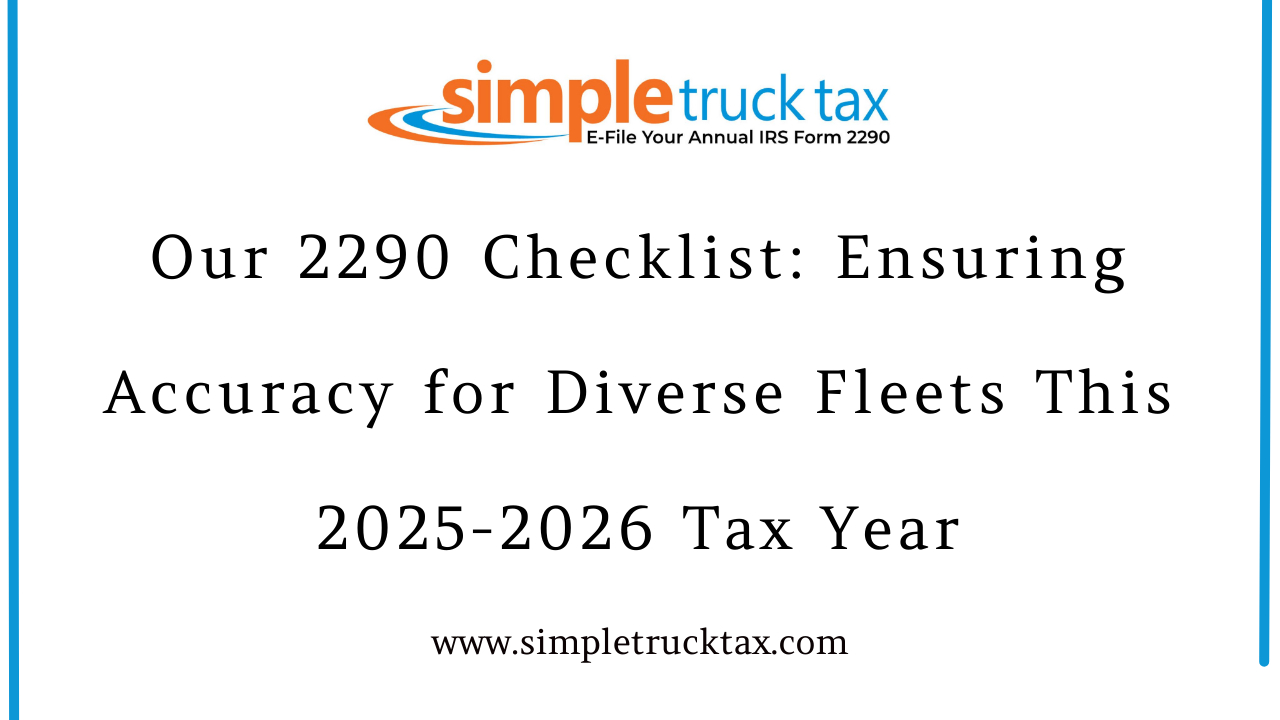
Our 2290 Checklist: Ensuring Accuracy for Diverse Fleets This 2025-2026 Tax Year
Tax filing under IRS Form 2290, for Heavy Highway Vehicle Use Tax (HVUT), is an important compliance matter for truck owners and fleet managers. The new tax term for heavy highway vehicles becomes effective from July 1, 2025, and the first date of filing for vehicles that were first used in that month will be September 2, 2025 (as August 31 is a weekend), so it is imperative that accurate filing is ensured this time. At [Your Company Name], we understand that dealing with different types of vehicles in a fleet complicates matters even further. So to help you complete your tax preparation accurately and on time, we have prepared this vital 2290 checklist.
1. Get Your Core Vehicle Information
Prior to even logging into our platform, you must have the following information at hand to make the e-filing process swift and smooth:
- Employer Identification Number (EIN): This is your unique taxpayer identification for business. Make sure it agrees with your IRS records.
- Vehicle Identification Numbers (VINs): Ensure that the VINs are entered accurately. It is well worth double-checking before you have to incur more headaches of having to do a VIN correction later.
- Taxable Gross Weight: Confirm taxable gross weight for each vehicle. Remember that taxability hinges upon the crossover of the 55,000-pound threshold. Ample computations are harnessed by our system to maintain correct computation of HVUT depending upon weight classes.
- First Used Month: Make a note of the month that each vehicle was first used on a public highway during the tax period (July 1, 2025 – June 30, 2026) as this dictates the filing deadline and pro-rated tax amount.
2. List Any Special Vehicle Classifications
- Suspended Vehicles (Low Mileage): Do you have trucks expected to travel 5,000 miles or less (or 7,500 miles or less for agricultural vehicles)? You still must file Form 2290 to report their suspended status. This avoids tax liability unless they exceed the mileage later in the tax year. Never disregard these as proper reporting can save a lot of money.
- Farm Use: If your heavy vehicle is mainly engaged in agriculture and meets the state registration, remember the 7,500-mile exemption. A confirmation shortchanges while filing can actually make the difference in your tax liability.
- Logging Vehicles: In cases wherein the vehicles are mainly engaged in logging operations, reduced tax rates may apply. Classification in these particulars requires strict focus.
- Sold, Stolen, or Destroyed Vehicles: Vehicles are subject to tax credits if sold, stolen, or destroyed prior to the end of the taxing period. Please remember that in these cases, you are required to keep detailed records.
3. Make Technological Use for Swift Compliance
E-filing Form 2290 these days is the ultimate in efficiency and accuracy. Our advanced platform understands what you input and smoothly walks you through the whole process to minimize erroneous claims.
- Bulk Upload for Ease: Another useful take when you have a big fleet is our bulk upload feature: upload multiple vehicle details in one fell swoop and save invaluable time.
- Automated Error Checks: We validate the input in real time, so any potential error must generate an alert before submission. This way, we guarantee that your HVUT return is accurate.
- Instant Stamped Schedule 1: An almost instant receipt from the IRS arrives as your Stamped Schedule 1 upon successful e-filing. It is crucial proof of payment in registering the vehicles and in satisfying state compliance.
With either the 2290 checklist and our very e-filing solutions at your rescue, you can confidently guide the Heavy Vehicle Use Tax season for your whole mixed fleet. Be compliant, stave off penalties, and drive your business away.